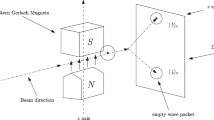Abstract
In the paper we look into the epistemology of quantum theory. The starting point is the previously established mathematical ambiguity. The perspective of our study is the way that Schrödinger described Einstein’s idea of physics epistemology. Namely, physical theory is a map with flags. Each flag must, according to Einstein in Schrödinger’s representation, correspond to a physical reality and vice versa. With the ambiguity transformed to quantum-like operators we are able to mimic quantum theory. Therefore we have created little flags. The question is raised whether nature itself is ambiguous. The created flags point at ambiguous nature. Or, nature is not ambiguous and the ambiguity can be repaired in mathematics.
Similar content being viewed by others
References
Bell JS (1964) On the Einstein Podolsky Rosen paradox. Physics 1:195
Einstein A, Podolsky B, Rosen N (1935) Can quantum-mechanical description of physical reality be considered complete? Phys Rev 47:777
Farasat F (1996) Introduction to generalized functions with applications in aerodynamics and aeroaucoustics. NASA
Geurdes H, Nagata K (2019a) A question about the consistency of Bell’s correlation formula. arXiv:1907.00621v1
Geurdes H, Nagata K (2019b) Bell’s correlation formula and anomalous spin. arXiv:1907.0448v1
Geurdes H, Nagata K, Nakamura T, Farouk A (2017) A note on the possibility of incomplete theory. arxiv:1704.00005
Haven E, Khrennikov A (2013) Quantum social science. Cambridge University Press, Cambridge
Howard D (1985) Einstein on locality and separability. Stud Hist Philos Sci 16:171–201
Howard D (1990) Nicht sein kann was nicht sein darf or the prehistory of EPR 1909–1935. In: Miller A (ed) Sixty-two years of uncertainty. Plenum, New York
Lighthill MJ (1966) Einfürung in die Theorie der Fourieranalysis und der verallgemeinerten Funktionen: chap 2, Die theorie der verallgemeinerte Funktionen. Hochschultaschenbücher, Mannheim
Merzbacher E (1970) Quantum mechanics. Wiley, New York
Molinini D (2019) The weak objectivity of mathematics and its reasonable effectiveness in science. Axiomathes. https://doi.org/10.1007/s10516-019-09449-8
Wigner E (1959) The unreasonable effectiveness of mathematics in the natural sciences. Commun Pure Appl Math 23:1–4
Wittgenstein L (1958) Philosophical investigations. Basil Blackwell, Oxford
Yessenin-Volpin AS, Hennix C (2001) Beware of the Gödel-Wette paradox. arXiv:0110094v2
Author information
Authors and Affiliations
Corresponding author
Additional information
Publisher's Note
Springer Nature remains neutral with regard to jurisdictional claims in published maps and institutional affiliations.
Rights and permissions
About this article
Cite this article
Geurdes, H. Quantum Epistemology from Mimicry and Ambiguity. Axiomathes 31, 73–83 (2021). https://doi.org/10.1007/s10516-020-09479-7
Received:
Accepted:
Published:
Issue Date:
DOI: https://doi.org/10.1007/s10516-020-09479-7




